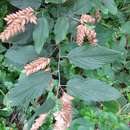en
names in breadcrumbs


Flemingia is a genus of plants in the legume family Fabaceae. It is native to Asia and the species are distributed in Bhutan, Burma, China, India; Indonesia, Laos, Malaysia, Nepal, Pakistan, Papua New Guinea, Philippines, Sri Lanka, Taiwan, Thailand and Vietnam.[1][2] The genus was erected in 1812.
The number of known species is ambiguous due to taxonomic problems; and is usually enumerated as more than 30. Burma and China have the highest record of Flemingia species with 16 each, followed by India (with 15 species), Thailand (11 species), Laos (10 species), Vietnam (8 species), Bhutan (1 species) and Nepal (5 species).[3]
Some species of Flemingia are used in the herbal medicine traditions of various Asian communities. This is attributed to their unique chemical properties, especially those of flavonoids and sterols. Their most common applications in traditional medicine are for epilepsy, dysentery, stomach ache, insomnia, cataract, helminthiasis, rheumatism, ulcer, and tuberculosis.
Members of Flemingia are shrubs, or herbs (or subshrubs); evergreen, or deciduous and perennial. They are generally about 0.2–1.5 m high. The stem is prostrate but weak. Leaves are small to medium-sized; not fasciculate, but alternate. The stem and leaves are pubescent, with dense hairs. Leaf blades are flat dorsoventrally. Flowers are aggregated in ‘inflorescences’; not crowded at the stem bases; in racemes, or in heads, or in panicles. Fruits are aerial, about 6–15 mm long; non-fleshy and hairy.[4][5][6]
Root tubers of Flamingia species have traditionally been used as food for Aborigines of the Northern Territory.[7]
Some important species include:
Flemingia is a genus of plants in the legume family Fabaceae. It is native to Asia and the species are distributed in Bhutan, Burma, China, India; Indonesia, Laos, Malaysia, Nepal, Pakistan, Papua New Guinea, Philippines, Sri Lanka, Taiwan, Thailand and Vietnam. The genus was erected in 1812.